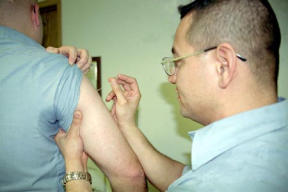Whidbey Island Naval Air Station personnel are given reminders and orders on a daily basis. Now they have to remember, “When the scab falls off, flush it down the toilet,” as one of the precautions they take after they receive a smallpox vaccination.
Naval Hospital Oak Harbor has received an initial allotment of smallpox vaccine and Monday designated military personnel began rolling up their sleeves for protection against a possible smallpox virus attack when they’re overseas.
NAS Whidbey’s Preventive Medicine Division, headed by Lt. Matthew Sullivan, began preparing months ago to administer the vaccine with an educational component, including how to care for the immunization site during the healing process, according to Sarah McGruder, Naval Hospital Oak Harbor Public Affairs Officer.
Education is given to all those who will administer the vaccine and all personnel who will receive the vaccine.
NAS Whidbey recipients of the smallpox vaccine thus far have been medical personnel who will comprise a “first responder” type unit, preparing in case smallpox ever reaches Naval Hospital Oak Harbor, and any deployable medical personnel. Soon all deployable NAS Whidbey personnel will also be fair game for needle prodding. With another possible Gulf War looming, many expect orders soon.
While Sullivan says the likelihood of the disease reaching the naval hospital is highly unlikely due to the fact “there is no small pox in existence on earth right now,” Sullivan and the Preventable Medicine Division want to be prepared in case the unforeseeable occurs. And in the area of Iraq, anything could happen.
The screening process occurs to prevent adverse reactions to the vaccine, which vaccine recipients get a grotesque glimpse of through posters and other smallpox paraphernalia that is scattered about the vaccination room. They are reminded to not touch the vaccination site, and to wash their hands so they can’t spread the disease to their eyes, nose, mouth or even others.
Depending on the scale of the vaccinations at any given time, larger education sessions might occur prior to the screening and immunizing phase, according to McGruder. For example, the Preventive Medicine Division may educate 500 personnel in the base theater, and then screen and immunize them over the next few days at other designated locations on base.
McGruder said the NHOA Preventive Medicine Department was authorized to order enough vaccine to inoculate medical personnel and specific units traveling to “high threat areas.”
Deployable Navy medical providers, who are the most likely to perform a function that could put them at risk of exposure, must all be vaccinated by the end of the month, according to Sullivan.
“A big part of the project right now is the paperwork side and accountability or recording the numbers we screened, how many we vaccinate, and how many we turn away,” said Sullivan, describing the numbers he must report to a national data base.
This week will focus on the continuing education, screening and training techniques for which the designated medical personnel will become qualified vaccinators.
“This training is very rigorous and explicit,” Sullivan said. “Every health care provider must study numerous medical references, view an online training presentation and observe and perform vaccinations under supervision.”
At this time only designated medical personnel and active duty deployable personnel have been authorized to be given the smallpox vaccination, according to Sullivan. They will report to their squadron flight surgeon for guidance. There are no immediate plans to vaccinate military family members, Sullivan added.
Anyone with questions about smallpox, the vaccine or any issues related to its safety, may visit the Department of Defense smallpox website www.smallpox.army.mil or the Center for Disease Control Website, http://www.bt.cdc.gov/agent/smallpox.
Questions relating to the administration of smallpox vaccine for NASWI may be directed to the base Environmental Health Officer, Lieutenant Matthew Sullivan at 257-5336 or Hospital Corpsman Third Class (HM3) James at 257-5950



